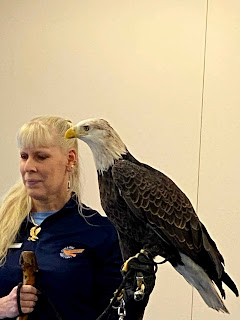Eagles
Mike and I went to an 'Eagle Watch' program at the Carlyle Library. We got to see two live eagles during the presentation and then were presented with a map of places to spot eagles on the lake. Mike and I only checked out one spot and were unlucky enough not to see one but the lecture was well worth our while anyway.
Two ladies from the World Bird Sanctuary near St. Louis brought the programs stars who represented two types of eagles. They showed us the Tsavo or serpent eagle and the Bald eagle.
The Tsavo, the serpent eagle was really pretty with different colors on its face and feet. They actually change these colors based on their mood. Pink would be a calm or resting mood and orange was an angry or fight type mood. Fortunately our bird was wearing an in between red color. They are normally found in Africa but our bird had been rescued from an illegal bird trafficking operation and could not be returned to the wild.
The serpent eagle has a very short tail which is helpful with 'steering'. It acts like a rudder for the bird and allows this eagle to be quickly adapt to the direction changes of its prey and makes for better maneuverability on land. Also, since the serpent eagle is after snakes that could be poisonous, they have armor type scales on their feet to protect them from bites. The eagle has eight talons on each foot and can use up to 800 pound of pressure on its prey with each foot.
Liberty, our bald eagle visitor, is a fish eagle. Their feet have scales that are designed to hold onto the slippery fish that they skim off of the top of the water. They love to hang around Carlyle lake because not only does it have the lake but in case it freezes over, they have access to running water near the dam and the old river channel. Bald eagles can withstand the cold because their talons are also doubly insulated and their 7000 feathers keep them warm.
Although bald eagles prefer to eat fish, they will eat ducks and geese, but if none are available they are opportunistic eaters. They will eat found food like road kill and are known as sky pirates who take food from other birds. Since they do not have the flight control of the Savo eagle with its short four inch tail, they are not going to be successful capturing live animals like rabbits.
It was disappointing not to see any live birds around the lake although I had never been to Carylyle lake before so I enjoyed seeing it. However, Mike and I saw two bald eagles on the way to church the next morning so my disappointment was definitely mitigated. I would say I definitely enjoyed my Eagle Watch weekend.
Other Interesting Facts:
- An bald eagle was actually named a balde eagle. Balde is an old English word meaning white headed.
- A bald eagle does not become totally white headed until they are five years old. Since the mortality rate for first year bald eagles is over 50% this is a badge of honor. Bald eagles can live up to 20 years in the wild and longer in captivity.
- Bald eagles once paired, remain together until one dies.
- Bald eagle nests are huge and heavy. The can average 8 feet wide by 13 feet deep and weigh a ton. Eagles return to their nests year after year.




No comments:
Post a Comment